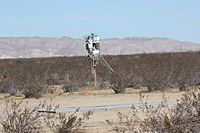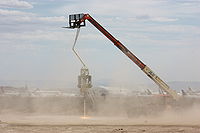- Masten Space Systems
-
Masten Space Systems, Inc. 
Type Private Industry Aerospace and defense Founded 2004 Headquarters Mojave, California, USA Key people Joel Scotkin, CEO
David Masten, CTO
Sean Mahoney, COO
Colin Ake, Business Development
Reuben Garcia, Systems Integration & Crew Chief
Alex Hreiz, Propulsion
Jonathan Powers
Nathan O'Konek
Richard Wagner
Travis O'Neal
Scott NietfeldProducts Suborbital spacecraft
Space systems
Throttleable rocket engines
Rocket Propulsion Hardware
Reusable Launch VehiclesServices Rocket Propulsion Design and Analysis
Space Hardware Test Services
Concept Demonstration
Vertical Landing SoftwareEmployees 12 (10/7/11) Website masten-space.com Masten Space Systems is an aerospace startup company in Mojave, California (formerly Santa Clara, California) that is developing a line of vertical takeoff, vertical landing (VTVL) spacecraft, initially for unmanned suborbital research flights and eventually intended to support unmanned orbital launches.
Contents
Overview
Masten Space Systems is a Mojave, California based rocket company that is currently developing a line of reusable VTVL spacecraft, and related rocket propulsion hardware.
Masten Space Systems competed in the NASA and Northrop Grumman Lunar Lander Challenge X Prize in 2009, winning the level one second prize of $150,000 [1][2] and the level two first prize of $1,000,000.[3][4] On November 2, 2009 it was announced that Masten Space Systems had won first place in the level two category, with Armadillo Aerospace coming in second.[5][6]
Xombie
Masten's Xombie (model XA-0.1B) won the US$150,000 second prize in the Level One competition of the Lunar Lander Challenge on October 7, 2009, with an average landing accuracy of 16 centimetres (6.3 in).[2]
After a tethered flight mishap[when?][clarification needed] that led to the XA-0.1 vehicle being retired, Masten recognized that a few of the important goals of XA-0.1 had not been achieved, most particularly demonstration of stable, controlled flight.[citation needed]
The primary goal of these two airframes was to demonstrate stable, controlled flight using a GN&C system developed in-house at Masten. XA-0.1B originally featured four engines with 1,000 pounds-force (4 kN) thrust, but was converted in Spring 2009 to be powered by one engine of 750 pounds-force (3 kN) thrust.[7]
XA-0.1B - nicknamed "Xombie" - first flew free of tether September 19, 2009 [8] and qualified for the Lunar Lander Challenge Level One second prize of $150,000 on October 7, 2009.[9]
Xoie
Masten's Xoie (model XA-0.1E) won the US$1,000,000 Level Two prize of the Lunar Lander Challenge on October 30, 2009. They beat Armadillo Aerospace by just a bit more than 24 inches (610 mm) of total landing accuracy, with an average accuracy of about 7.5 inches (190 mm) on the two landings in the round-trip competition flight.[10][4]
Xoie has an aluminum frame and features a version of Masten's 750 pounds-force (3 kN) thrust engine that produces around 1,000 pounds-force (4 kN) of thrust. "Xoie" - as the craft is nicknamed - qualified for the Lunar Lander Challenge level two on October 30, 2009.[11]
Xaero
The Xaero reusable launch vehicle is a vertical-takeoff, vertical-landing (VTVL)[12] unmanned rocket which is being developed by Masten in 2010-2011. It has been submitted to NASA as a potential suborbital vehicle for use as a suborbital reusable launch vehicle (sRLV) for carrying research payloads under NASA's Flight Opportunities Program (initially known as the CRuSR - Commercial Reusable Suborbital Research - program), projecting 30 km (19 mi) altitude in initial flights of five to six minutes duration, while carrying a 10 kg (22 lb) research payload.[12]
Other products and services
In addition to its line of vehicles, Masten Space Systems is currently offering its internally developed igniters and engines commercially to interested and qualified parties.[13] Masten also has stated its' intent at multiple conferences to participate in technology maturation and proof of concept projects, though
See also
 External media
External mediaVideo of MSS craft
Official MSS Youtube channel- List of private spaceflight companies - A compiled list of private spaceflight companies
- Pressure-fed cycle (rocket)
References
- ^ "Masten Space Systems Qualifies for Level One Prize in Lunar Lander Challenge". October 8, 2009. http://www.nasa.gov/offices/ipp/innovation_incubator/centennial_challenges/cc_masten_level_1_prt.htm.
- ^ a b "Masten and Armadillo Claim Lunar Lander Prizes". Centennial Challenges: NASA's Prize Program for the "Citizen Inventor". NASA. 2009-11-02. http://www.nasa.gov/offices/ipp/innovation_incubator/centennial_challenges/cc_ll_feature_lvl2.html. Retrieved 2011-03-10. "In the Level One competition, Armadillo Aerospace previously claimed the first place prize of $350,000 in 2008. Masten Space Systems qualified for the remaining second place prize on Oct. 7, 2009 with an average landing accuracy of 16 cm. There were no other qualifying Level One flights this year and so the Masten team will receive the second place prize of $150,000."
- ^ "Masten Qualifies for $1 Million Prize". October 30, 2009. http://thelaunchpad.xprize.org/2009/10/masten-qualifies-for-1-million-prize.html.
- ^ a b "Masten and Armadillo Claim Lunar Lander Prizes". Centennial Challenges: NASA's Prize Program for the "Citizen Inventor". NASA. 2009-11-02. http://www.nasa.gov/offices/ipp/innovation_incubator/centennial_challenges/cc_ll_feature_lvl2.html. Retrieved 2011-03-10. "With only a few days remaining in the 2009 competition period, Masten Space Systems of Mojave, California successfully met the Level Two requirements for the Centennial Challenges - Lunar Lander Challenge and by posting the best average landing accuracy, won the first place prize of $1,000,000.The flights were conducted with their “Xoie” (XA-0.1E) vehicle on Oct. 30 at the Mojave Air and Space Port. Armadillo Aerospace, the long-time leader in Lunar Lander Challenge efforts, was the first team to qualify for the Level Two prize with successful flights on Sept. 12 in Caddo Mills, Texas. The average landing accuracy determines which teams will receive first and second place prizes. The average accuracy for Armadillo Aerospace flights was 87 cm. but the Masten team achieved an accuracy of 19 cm, moving them into first place. Armadillo Aerospace will receive the $500,000 second place prize."
- ^ "NASA and X Prize Announce Winners of Lunar Lander Challenge" (Press release). NASA. 2009-11-02. http://www.nasa.gov/home/hqnews/2009/nov/HQ_09-258-Lunar_Lander.html. Retrieved 2009-11-02.
- ^ "X PRIZE Foundation and NASA Cap Amazing Lunar Lander Competition and Award $2 Million in Prizes" (Press release). X-Prize Foundation. 2009-11-02. http://www.xprize.org/media-center/press-release/x-prize-foundation-and-nasa-cap-amazing-lunar-lander-competition-and-awar. Retrieved 2009-11-02.
- ^ Goff, Jonathan (April 17, 2009). "Post Space Access Technical Update". http://masten-space.com/blog/?p=266.
- ^ Mealling, Michael (September 19, 2009). "First Successful Free Flight". http://masten-space.com/blog/?p=345.
- ^ "Masten Space Systems Qualifies for Level One Prize in Lunar Lander Challenge". October 8, 2009. http://www.nasa.gov/offices/ipp/innovation_incubator/centennial_challenges/cc_masten_level_1_prt.htm.
- ^ Paur, Jason (2009-11-04). "Xoie Claims $1 Million Lunar Lander Prize". Wired. http://www.wired.com/autopia/2009/11/xoie-claims-1-million-lunar-lander-prize/. Retrieved 2011-03-10. "Leaving it to the last minute, the team from Masten Space Systems has made a come-from-behind effort to win the $1 million prize after successfully flying its lunar lander last week. The team flew a new ship, called Xoie, to qualify for level 2 of the Northrop Grumman Lunar Lander Challenge. ... more than 1000 pounds of thrust ... managed to make the round trip with an average landing accuracy of about 7.5 inches."
- ^ "Masten Qualifies for $1 Million Prize; Unreasonable Rocket Completes 1st Attempt". October 30, 2009. http://thelaunchpad.xprize.org/2009/10/masten-qualifies-for-1-million-prize.html.
- ^ a b "sRLV platforms compared". NASA. 2011-03-07. https://c3.ndc.nasa.gov/flightopportunities/platforms/compare/. Retrieved 2011-03-10. "Xaero: Type: VTVL/Unpiloted"
- ^ "Masten Space Systems Products". November 1, 2009. http://masten-space.com/products-hardware.html.
External links
- Masten Space Systems - Company homepage
- Masten YouTube - Company YouTube Channel
Categories:- Mojave Air & Space Port
- Private spaceflight companies
Wikimedia Foundation. 2010.


